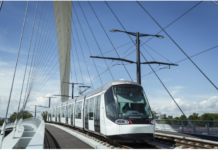Exploring Jaipur: The Pink City
Jaipur, the capital of Rajasthan, also known as Pink City is famous for its vibrant pink-hued buildings, rich history, and architecture. Established in 1727 by Maharaja Sawai Jai Singh II, the city is renowned as one of India’s earliest planned urban areas. The city was designed by architect Vidyadhar Bhattacharya, following the principles of Vastu Shastra. In 1876 the city was painted pink to honour the visit of the Prince of Wales, which resulted in its famous nickname, the Pink City.
Jaipur is a major tourist destination and cultural hub in India. It is known for its vibrant festivals and rich heritage. The city’s economy primarily depends on tourism, handicrafts, and gemstone trading.

Need for Metro System for Pink City
- Increasing Population: Over the years, the city’s population has seen significant growth which positioned Jaipur 10th most populous city in the country. As of 2011, the city had a population of 31 lakhs and it is projected to be 81 lakh in 2031. This exponential rise in residents necessitates a public transportation system to efficiently accommodate increasing commuter demand.
- Traffic Congestion: The city’s vehicular density has reached alarming levels, with approximately 25,048 vehicles per square kilometre, far exceeding the state average of 4,299 vehicles per square kilometre. This surge in vehicles has led to severe congestion, particularly in areas like Chandpole, which witnesses a daily influx of 330,000 vehicles. Consequently, the average travel time in Jaipur has increased to 28 minutes and 28 seconds per 10 kilometres. This critical situation highlights the urgent need for a faster and more efficient transit solution.
To address these concerns, the Jaipur Metro Rail Project was introduced to provide a sustainable and efficient urban transport solution. The article studies the operational route of the Jaipur Metro and also aims to provide insights into its expansion plan as Pink City expands.

Jaipur Metro: A New Era of Connectivity
The Jaipur Metro project comprises two planned corridors: the East-West Corridor and the North-South Corridor. It is the fifth metro rail system in India, following successful projects in Delhi, Mumbai, Bengaluru, and Kolkata. As an Urban Mass Rapid Transit System (MRTS), Jaipur Metro currently operates a single corridor spanning 11.91 km.

Development of DPR for Jaipur Metro Rail Project
The Detailed Project Report (DPR) for the Jaipur Metro Rail Project was initially submitted by the Delhi Metro Rail Corporation (DMRC) in March 2010. It included two corridors:
- Corridor-1: Durgapura to Ambabari
- Corridor-2: Mansarovar to Badi Chaupar
Revisions and Changes:
- April 2011: The DPR was revised, extending Corridor-1 to Sitapura Industrial Area instead of ending at Durgapura.
- March 2012: A decision was made to bifurcate the DPR into two phases:
- Phase I: Mansarovar to Badi Chaupar
- Phase II: Sitapura Industrial Area to Ambabari)
JMRC Incorporation: For effective implementation of the Jaipur Metro, A Special Purpose Vehicle (SPV), Jaipur Metro Rail Corporation ( JMRC) was incorporated on 1 January 2010.


Phase 1
Overview
Phase 1 of the Jaipur Metro project consists of a single corridor, the Pink Line, spanning 11.98 km (operational). It has been planned and implemented in four sections:
| Phase | Route | Length | Type | Status | Operational Since |
| Phase 1A | Mansarovar to Chandpole | 9.63 km | Elevated & Underground | Operational | June 3, 2015 |
| Phase 1B | Chandpole to Badi Chaupar | 2.35 km | Underground | Operational | September 23, 2020 |
| Phase 1C | Badi Chaupar to Transport Nagar | 3.41 km | Elevated | Under Implementation | TBD |
| Phase 1D | Mansarovar to Ajmer Road | 1.35 km | Elevated | Under Implementation | TBD |
Note: The Phase-1C and Phase-1D extensions of Jaipur Metro’s corridor 1 were officially announced by the Rajasthan state government in the 2022–2023 budget as part of the metro expansion plans.
Key Specification
| Speed and Track | Top Speed: 80 kmphAverage Speed: 32 kmphTrack Gauge: Standard Gauge – 1435 mm |
| Electrification | 25 kV, 50 Hz AC OHE |
| Signaling | Cab Signalling/Distance to Go |
| Rolling Stock | 40 coaches (10 train-sets x 4) supplied by BEML |
Route Information
Jaipur Metro Operational Route
Phase 1A and Phase 1B
Line-1 – Pink Line: Mansarovar – Badi Chaupar
| Description | Phase-1A (Mansarovar to Chandpole) | Phase-1B (Chandpole to Badi Chaupar) | Total Phase-1 (Mansarovar to Badi Chaupar) |
| Elevated Route Length (in km) | 9.13 | 0 | 9.13 |
| Underground Route Length (in km) | 0.5 | 2.35 | 2.85 |
| Total Route Length (in km) | 9.63 | 2.35 | 11.98 |
| Elevated Stations | 8 | 0 | 8 |
| Underground Stations | 1 | 2 | 3 |
| Total Stations | 9 | 2 | 11 |
| Total Project Cost (₹ in Crore) | 2,023 | 1,126 | 3,149 |
Stations Names: Mansarovar, New Aatish Market, Vivek Vihar, Shyam Nagar, Ram Nagar, Civil Lines, Railway Station, Sindhi Camp and Chandpole, Chhoti Chaupar, and Badi Chaupar
Jaipur Metro Under Implementation Route
Phase 1C
Line-1 – Pink Line: Badi Chaupar – Transport Nagar (Phase 1C)
| Description | Details |
| Total Route Length (in km) | 3.41 |
| Underground Route Length (in km) | 2.65 |
| Elevated Route Length (in km) | 0.76 |
| Number of Stations | 2 |
| Estimated Project Cost (₹ in Crore) | 980.08 |
Station Names: Ramganj Chaupar (underground) & Transport Nagar (elevated)
Phase 1D
Line-1 – Pink Line: Mansarovar to Ajmer Road Chauraha (Phase 1D)
| Description | Details |
| Total Route Length (in km) | 1.35 |
| Type | Elevated |
| Number of Stations | 1 |
| Estimated Project Cost (₹ in Crore) | 204.81 |
| Estimated Project Cost (₹ in Crore) | 980.08 |
Station Names: Ajmer Road Chauraha
Jaipur Metro Phase 2 (Proposed Route)
Overview
Initial Planning and DPR Bifurcation
The concept of Phase 2 for Jaipur Metro emerged when the Detailed Project Report (DPR) was bifurcated into Phase 1 & Phase 2. The updated DPR in 2012 proposed a 23.099 km route from Sitapura Industrial Area to Ambabari, comprising 5 underground and 15 elevated stations.
Revisions in 2014
Further modifications were made to the DPR in April and July 2014 to adjust the metro alignment for Jaipur Airport’s Air Funnel and ensure connectivity to the Collectorate.
Impact of Metro Rail Policy 2017
With the introduction of the Metro Rail Policy 2017, new guidelines and elements had to be considered. As a result, the 2011 DPR was deemed outdated and could not be implemented.
DPR Update in 2020
In 2020, the Delhi Metro Rail Corporation (DMRC) updated the DPR, proposing a 23.51 km fully elevated route (Orange Line) with 21 elevated stations. The estimated project cost at the January 2020 price level was ₹4,602 crore, including Interest During Construction (IDC).
Further Modifications in 2024
In 2024, the Government of Rajasthan announced an extension of the metro line northwards from Ambabari to Vidhyadhar Nagar, adding approximately 7 km. This change led to the reconsidering of the entire Phase 2. As a result, Jaipur Metro Rail Corporation (JMRC) restructured the project into:
- Phase 2A: Ambabari – Sitapura
- Phase 2B: Ambabari – Vidhyadhar Nagar
Review of DPR in 2024
In November 2024, JMRC appointed RITES Ltd. to review the Jaipur Metro Phase 2 project’s DPR, considering the latest modifications and feasibility aspects.
Tentative Route of Phase 2
Ambabari – India Gate (Sitapura Industrial Area)
| Description | Details |
| Total Route Length (in km) | 23.51 km |
| Type | Elevated |
| Number of Stations | 21 |
| Estimated Cost (₹ in Crore) | 4,602 (including IDC) |
Station Names: Ambabari, Pani Petch, Subash Nagar, Collectorate, Chandpole (interchange), Government Hostel, Ashok Marg, SMS Hospital, Narayan Singh Circle, Ram Bagh Circle, Tonk Phatak, Gandhi Nagar Raiway Station, Dev Nagar, Mahaveer Nagar, Durgapura, B2 Bypass, Sanganer Sethu, Pinjarapole Gaushala, Haldi Ghati Gate, Kumbha Marg and India Gate
Financial Performance of Jaipur Metro As per the 14th Annual Report of JMRC
The Jaipur Metro Rail Corporation (JMRC) continues to face financial challenges due to high recurring expenses on salaries, administrative costs, and depreciation. The company reported operational losses despite revenue generation from fare and non-fare sources. However, due to profit from the sale of land, JMRC managed to achieve a net profit of ₹14,329.51 lakh for the financial year 2022-23. The detailed financial performance is outlined in the table below:
| Particulars | Amount (₹ in lakhs) |
| Total Revenue (excluding grant) | 2858.39 |
| Less: Total Expenses (excluding depreciation & finance cost) | 7234.96 |
| Operating loss before depreciation & finance cost | 4376.57 |
| Add: Depreciation (net of amortization of grant) | 8363.11 |
| Operating loss after depreciation before finance cost | 12739.68 |
| Add: Finance Cost (Interest) | 3347.38 |
| Operating loss after depreciation & finance cost | 16087.06 |
| Less: Grant-in-aid from RTIDF | 8156.57 |
| Loss before Exceptional Item and Tax | 7930.49 |
| Less: Exceptional Item and Tax | 22260 |
| Net Profit | 14329.51 |
Comparison of Financial Performance (₹ in lakhs)
| Particulars | For the year ended on 31st March, 2023 | For the year ended on 31st March, 2022 |
| Total Income | ₹13,207.41 lakh | ₹12,669.73 lakh |
| Revenue from Operations | ₹2,544.60 lakh | ₹1,324.77 lakh |
| Other Income (including interest) | ₹313.79 lakh | ₹136.77 lakh |
| RTIDF Grant-in-aid | ₹8,156.57 lakh | ₹9,000.00 lakh |
| Deferred Capital Grant Amortized | ₹2,192.45 lakh | ₹2,208.19 lakh |
| Total Expenses | ₹21,137.90 lakh | ₹20,994.50 lakh |
| Revenue Expenses for the Year | ₹7,234.96 lakh | ₹6,141.34 lakh |
| Depreciation and Amortization | ₹10,555.56 lakh | ₹10,515.48 lakh |
| Finance Cost (Interest) | ₹3,347.38 lakh | ₹4,337.68 lakh |
| Profit / (Loss) before Exceptional Item and Tax | (₹7,930.49 lakh) | (₹8,324.77 lakh) |
| Exceptional Item | ₹22,260.00 lakh | ₹0.00 lakh |
| Tax Expenses (Net) | ₹0.00 lakh | ₹0.00 lakh |
| Profit / (Loss) after Tax | ₹14,329.51 lakh | (₹8,324.77 lakh |
Non-Fare Box Revenue Earned During 2022-23 as per the 14th annual report of JMRC
| Item | Revenue (₹ in Lakh) | Percentage |
| License fee from advertisement rights | 351.07 | 52.17% |
| Lease Rent from Indoor Mobile Coverage License | 63.19 | 9.39% |
| License Rent from Parking | 41.04 | 6.10% |
| Lease Rent from Rooftop Tower | 50.84 | 7.55% |
| Lease Rent from Retail Spaces | 53.84 | 8.00% |
| Other | 112.98 | 16.79% |
| Total | 672.96 | 100.00% |
Ridership & Fare Box Revenue
| Date/Period | Ridership (per day) | Total Ridership | Fare Box Revenue (₹) |
| 01.04.2022 | 25,582 | – | – |
| 31.03.2023 | 35,768 | – | – |
| FY 2022-23 (Total) | – | 1,34,08,531 | 18,55,57,094 |
| FY 2022-23 (Average) | 36,736 | – | – |
| 01.04.2023 – 31.08.2023 | 46,868 | – | – |
| 04.09.2023 | 55,674 | – | – |
Impact of Jaipur Metro
1. Improved Urban Mobility
With Jaipur’s population expected to reach 81 lakh by 2031, the Jaipur Metro will reduce dependency on private vehicles and streamline connectivity in the Pink City. Once Phase 2 becomes operational, it will further enhance connectivity to Jaipur Airport, commercial hubs, and densely populated areas like Vidhyadhar Nagar.
2. Environmental Benefits
Jaipur Metro’s expansion has the potential to make the city cleaner and greener by reducing reliance on private vehicles. As more commuters shift to the metro, there will be a decline in vehicular emissions, which will result in improved air quality.
3 Economic Growth and Urban Development
The Jaipur metro will enhance connectivity to business and industrial areas like Sitapura, increasing employment opportunities and commercial activity. Additionally, properties near metro corridors tend to appreciate in value, attracting investments in real estate and retail infrastructure.
4. Low Ridership Levels
Although Jaipur Metro’s ridership has grown over the years, it still operates below its full capacity. State government officials acknowledge that delays in metro expansion have affected daily ridership, which for a long time remained between 19,000 to 25,000 passengers. However, in recent years, ridership has gradually increased to 55,000 daily passengers.
Conclusion
The Jaipur Metro has improved urban mobility and offered a reliable and efficient transit system for the city. While Phase 1 is operational and expanding, the progress of Phase 2 remains pending, affecting planned connectivity to key areas like Sitapura Industrial Area and Vidhyadhar Nagar. The delay in Phase 2’s implementation has slowed the expected benefits of extended metro coverage, including improved access to commercial and residential hubs. The timely execution of Phase 2 will be essential to meet Jaipur’s growing transportation demands, reduce traffic congestion, and enhance connectivity for daily commuters and businesses.





